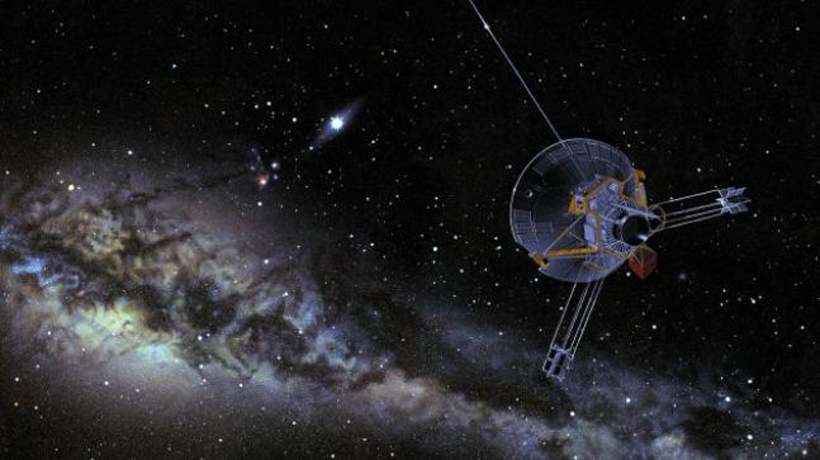Trending Now
- 830 voters names go missing in Kavundampalayam constituency
- If BJP comes to power we shall consider bringing back electoral bonds: Nirmala Sitaraman
- Monitoring at check posts between Kerala and TN intensified as bird flu gets virulent in Kerala
Education
Are pulsars the new satellites? NASA tests could make ‘golden record’ a reality
![]() January 19, 2018
January 19, 2018
A new NASA experiment shows how pulsars like LGM-1 could be used to navigate future missions to deep space with the right sensors and navigational algorithms. Their tests sparked the possibility that a spacecraft could autonomously determine its position in space by timing the reception of signals from multiple pulsars– without human instruction!
HOW THIS PULSAR NAVIGATION DISCOVERY CAME TO BE
1.The pulsar-navigation experiment is known as the Station Explorer for X-ray Timing and Navigation Technology (SEXTANT)
2.Last November, the Neutron Star Interior Composition Explorer (NICER) spent a day and a half looking at a handful of pulsars
3.By measuring tiny changes in the arrival time of the pulses, NICER could pinpoint its location to within 5 kilometres
4.This was the first demonstration in space of the long-sought technology known as pulsar navigation
5.One day, the method could help spacecraft steer themselves without regular instructions from Earth
6.Keith Gendreau, an astrophysicist at NASA’s Goddard and the mission’s principal investigator said ”it’s a great way to apply some of our astrophysics to exploration goals that include going into the outer Solar System and beyond,” reported Nature
7.Gendreau reported the findings last week at a meeting of the American Astronomical Society
WHAT PULSARS REALLY ARE
1.Pulsars are ultra-dense leftovers of exploded stars that give off beams of powerful radiation as they rapidly spin
2.Some emit radiation blasts as often as every few thousandth of a second
3.For decades, aerospace engineers have dreamt of using these consistently repeating signals for navigation, just as they use the regular ticking of atomic clocks on satellites for GPS
TIMELINE OF PULSAR NAVIGATION
1.In 1999-2000, the US Naval Research Laboratory flew a satellite experiment that showed that, in theory, spacecrafts could orient themselves using pulsars
2.The European Space Agency has explored the concept in recent years, with researchers calculating the margin at which a spacecraft could use pulsars to locate itself
3.In November 2016, China launched an experimental pulsar-navigation satellite, called XPNAV-1
4.NICER was installed on the International Space Station in June 2017 and its main job has been to measure the size of pulsars to better understand the matter that makes them up
5.In the recent SEXTANT experiment carried out by NICER, its property of navigation was discovered
SEXTANT’S FINDINGS
1.SEXTANT timed X-ray flashes coming from 5 pulsars, one of which is the closest and brightest known millisecond pulsar
2.The mission watched each of the stellar beacons for about 5to 15 minutes before pivoting to look at the next
3.By measuring tiny changes in the signals’ arrival time as the experiment orbited Earth, NICER could independently calculate its own position in space!
HOW IS PULSAR NAVIGATION BETTER?
1.Without pulsar navigation, spacecrafts must communicate with Earth regularly to confirm their position
2.This communication happens through systems such as NASA’s Deep Space Network (DSN), a group of giant satellite dishes
3.DSN is time-consuming, expensive, and gets more difficult as the probe travels farther from Earth
4.Pulsar navigation might work well to address all of DSN’s shortcomings, and its greatest benefits is autonomy
5.It could free probes to do many navigation-related tasks without waiting for human instructions
6.This GPS technique could also provide a self-check on how well a spacecraft’s conventional navigation systems are doing, says a NICER team member
NASA’S ROLE
NASA helped fund the test to see whether pulsars could be used as a back-up navigation method when its planned Orion crew capsule takes astronauts beyond low Earth orbit, sometime in the 2020s.
FUNCTIONING OF THE NICER
1.NICER used 52 small x-ray telescopes for its study, but a single such telescope could probably do the job too, says the study investigator
2.The instrument might weigh as little as 5 kilograms, making it relatively inexpensive to add to space missions, where more mass means more money needed to launch
3.The team plans to repeat the experiment in the coming months, hoping to reduce the margin of error to one kilometre or less
‘GOLDEN RECORD’
1.Gendreau notes that the famous ‘golden record’ aboard NASA’s Voyager spacecraft carries a map that pinpoints the location of the Solar System relative to 14 pulsars
2.If an alien civilization ever found the record, it could use it to locate Earth
3.”As a kid, I heard Carl Sagan talk about the golden record,” Gendreau says. “And now we’re actually doing it.”
























